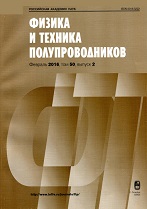|
Manufacturing, processing, testing of materials and structures
Formation of a stepped Si(100) surface and its effect on the growth of Ge islands
M. Yu. Yesina, A. I. Nikiforovab, V. A. Timofeeva, A. R. Tuktamysheva, V. I. Mashanova, I. D. Loshkareva, A. S. Deryabina, O. P. Pchelyakovab
a Rzhanov Institute of Semiconductor Physics, Siberian Branch of Russian Academy of Sciences, Novosibirsk
b Tomsk State University
Abstract:
The transition from a two-domain to one-domain surface on a Si(100) substrate is investigated. It is demonstrated using reflection high-energy electron diffraction that at a temperature of 600$^{\circ}$C and a deposition rate of 0.652 $\mathring{\mathrm{A}}$/s onto a Si(100) substrate pre-heated to 1000$^{\circ}$C and inclined at an angle of 0.35$^{\circ}$C to the plane, a series of reflections from the 1 $\times$ 2 superstructure completely vanishes at a constant flow of Si. This is attributed to the transition of the surface from monoatomic to diatomic steps. At growth rates lower than 0.652 $\mathring{\mathrm{A}}$/s, the transition from a two-domain to one-domain surface is also observed; with a decrease in the growth rate, the intensity ratio $I_{2\times1}/I_{1\times2}$ decreases and the maximum of the dependences shifts toward lower temperatures. The complete vanishing of the series of superstructural reflections after preliminary annealing at a temperature of 700$^{\circ}$C is not observed; this series only vanishes after annealing at 900 and 1000$^{\circ}$C. The growth of Ge islands on a Si(100) surface preliminary annealed at a temperature of 800$^{\circ}$C is studied. It is shown that the islands tend to nucleate at the step edges. A mechanism of Ge island ordering on the Si(100) surface is proposed.
Received: 25.04.2017
Accepted: 02.05.2017
Citation:
M. Yu. Yesin, A. I. Nikiforov, V. A. Timofeev, A. R. Tuktamyshev, V. I. Mashanov, I. D. Loshkarev, A. S. Deryabin, O. P. Pchelyakov, “Formation of a stepped Si(100) surface and its effect on the growth of Ge islands”, Fizika i Tekhnika Poluprovodnikov, 52:3 (2018), 409–413; Semiconductors, 52:3 (2018), 390–393
Linking options:
https://www.mathnet.ru/eng/phts5906 https://www.mathnet.ru/eng/phts/v52/i3/p409
|


| Statistics & downloads: |
| Abstract page: | 32 | | Full-text PDF : | 12 |
|





 Contact us:
Contact us: Terms of Use
Terms of Use
 Registration to the website
Registration to the website Logotypes
Logotypes








 Citation in format
Citation in format 